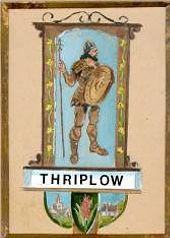 |
| Back to home page |
 |
Derivation of the name Thriplow. When investigating an area name such as Thriplow it is always worth breaking the name down into its syllables. In our case the name seems to split easily into two components, Thrip and low.
From the study of the origins of words and how the meanings have changed over time (this is called etymology) we can see that the low part of the name had a definite meaning in Old English. It is usually translated into modern English as a tumulus mound. This description fits the topography of Thriplow very well with a Bronze Age tumulus near to the present day church. However what is to be made of the Thrip part of the name?
The traditional view is that it is the name of the person cremated in the tumulus, and so the name becomes Tryppa's Hill If this is to be the interpretation then it becomes a remarkable feat of memory as by the time the Anglo-Saxons appeared the tumulus was already over 2000 years old. (There is of course no written record until late Saxon/Norman times.) |
|
Another interpretation suggested (Elkwall, The Oxford Dictionary of English Place Names, 1940) is that it belongs to another Old English word "treppan" to tread. Which ever is right, it remains a fascinating analysis of an English place name. Links to more details.... |
|
| Documentary evidence | Plane table surveying |
| Place name analysis | Resistivity surveying |
| Aerial photography analysis | Dowsing and pond dipping |
| Geology | Courses and visits |
| Soil sampling | Community links |
| Metal detecting | Acknowledgements |